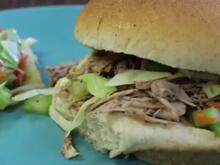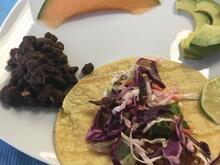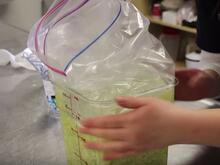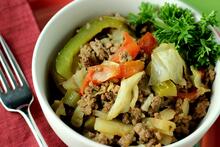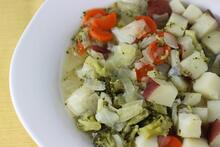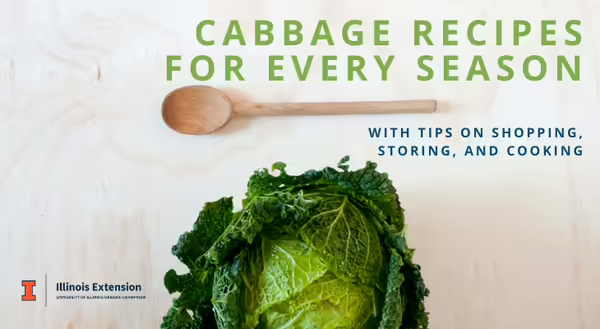
There are three things I appreciate about cabbage. One, a single cabbage gives a lot of cut or shredded pieces. Two, it has great shelf life. If I only need part of a cabbage for a recipe, the remaining cabbage seems to last for weeks in my fridge. (Yes, there are varieties of cabbage that are exceptions to this long shelf life.) Three, as I will share later in the post, cabbage is economical (read: cheap).
Nutritionally, 1 cup of green cabbage contains around 20 calories, 5g carbohydrates, 2g fiber, and is a source of vitamins and minerals including vitamin K, folate (a B vitamin), magnesium, potassium, and phosphorus. On its own, cabbage is not a significant source of fat, protein, or sodium.
Many of us may be familiar with green, red/purple, and savoy cabbages that are heavy, compact, and round like a globe or ball. You can also find Chinese cabbages, such as bok choy, napa, and michihili, which have an elongated shape.
- Buy:
- Whole: Look for whole heads of cabbage that are heavy for their size and firm. Avoid cabbages with obvious soft spots, discolored or wilted leaves, or mold.
- Pre-cut: Bags of pre-cut or pre-shredded cabbage - or coleslaw mix - are also available in many stores. These are a great "healthy convenience" item to save prep time in the kitchen. Fresh sauerkraut is also available in bags. Check "use by" or "best by" dates on these packages for the freshest product.
- Canned or jarred: Also shop for canned or jarred cabbage, including plain, pickled, and sauerkraut styles.
- Price: In general, cabbages - particularly green and red/purple globe-type cabbages - are inexpensive. Fresh green cabbages average around $0.60 per pound and red/purple cabbages average $1.00 per pound, according to the USDA. Remember, even if a cabbage is cheap per pound, most heads of cabbage are large and heavy, which increases their total price. Chinese cabbages may be more expensive.
- Store:
- Store whole, uncut heads of cabbage in the refrigerator for several weeks. Be aware that loose leaf cabbages, like bok choy, may only last a few days before their leaves wilt.
- If buying pre-cut cabbage in bags, refrigerate and use by the date on the package.
- Canned or jar cabbage can be stored at room temperature. Once opened, refrigerate any leftovers within 2 hours and use within a few days.
- Prepare: Remove outer leaves and rinse under cool water before cutting into the size for your recipe.
- Preserve: The National Center for Home Food Preservation has directions on freezing, pickling, and fermenting cabbage. Plus see a recipe below for fresh sauerkraut.
- Eat: Cabbage can be eaten raw or cooked and works well in a variety of cold-weather and hot-weather recipes. Below are some favorites from Illinois Extension.
Roasted Parmesan Napa Cabbage Wedges | Print recipe
Braised Napa Cabbage with Carrots and Leek | Print recipe | Video
Autumn Pork Sandwich with Apple Slaw | Print recipe | Video
Blackened Fish Tacos with Cilantro Lime Slaw | Print recipe | Video
Fresh Sauerkraut | Print recipe | Video
Hamburger Skillet Dinner | Print recipe
Fall Vegetable Soup | Print recipe
Red and Green Holiday Slaw | Print recipe
References:
- University of Tennessee, Cabbage, N/D
- University of Florida IFAS Extension, Gardening Solutions, Cabbage, N/D
- US Department of Agriculture, Agriculture Research Service, National Nutrient Database for Standard Reference
Healthy Eats and Repeat
How much difference is there between canned and frozen foods? How should you cook venison? When is the best time to buy avocados? Get answers to these questions as well as other tips, tutorials and recipes for common kitchen foods and items with University of Illinois Extension Nutrition & Wellness Educator Caitlin Mellendorf’s blog Healthy Eats and Repeat. Build your best life. Trust Extension to help.
Caitlin Mellendorf is an Illinois Extension Nutrition and Wellness Educator serving DeWitt, Macon and Piatt Counties in Central Illinois. She is a Registered Dietitian and her work focuses on helping community members gain the knowledge, skills and tools to live healthier, more nutritious lifestyles. This includes providing programs and answering questions about heart health, diabetes, food safety, food preservation, grocery shopping and cooking. You can reach Caitlin by email at chuth2@illinois.edu or call 217.877.6042. Check out her nutrition blog Healthy Eats and Repeats for seasonal recipes and of an exploration of common kitchen foods.


